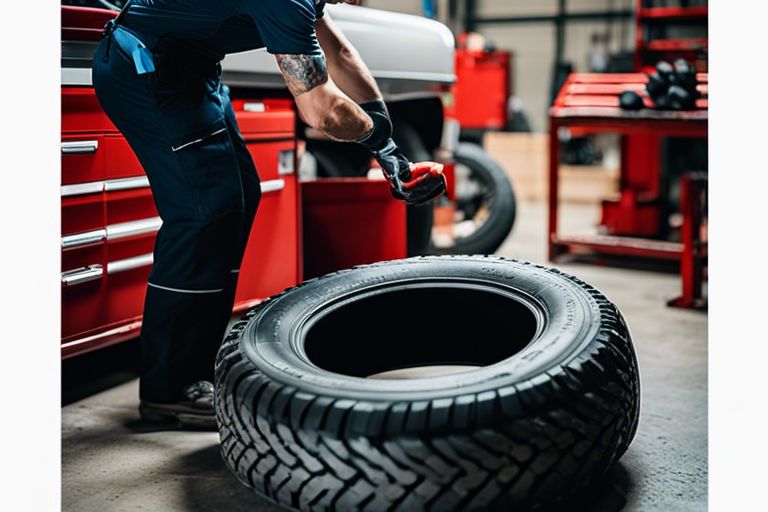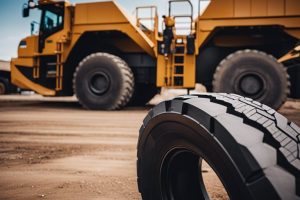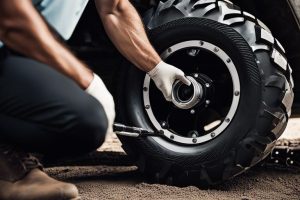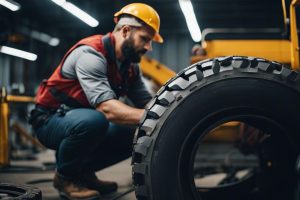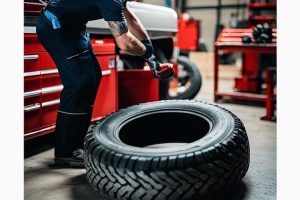Ensuring that Off-The-Road (OTR) tires are properly inflated is crucial for both performance and safety. Incorrect tire pressure can lead to premature wear, decreased fuel efficiency, and even accidents. In this comprehensive guide, we will cover the dos and don’ts of inflating OTR tires to help beginners navigate this necessary maintenance task with confidence. From the recommended pressure levels to the tools needed, follow these expert tips to keep your OTR tires in top condition and maximize their lifespan.
Key Takeaways:
- Proper inflation: Ensuring OTR tires are inflated to the correct pressure is crucial for maximizing tire performance and lifespan.
- Use the right equipment: It is important to use a calibrated tire pressure gauge and a high-quality air compressor to inflate OTR tires accurately.
- Avoid overinflation: Overinflating OTR tires can lead to uneven wear, reduced traction, and potential blowouts, so always follow the recommended inflation pressure guidelines.
Pre-Inflation Preparation
The process of properly inflating OTR tires starts with adequate pre-inflation preparation. This crucial step ensures that the tires are ready for inflation and helps prevent any potential hazards or mishaps during the inflation process.
Safety Tips
Before inflating OTR tires, it is important to prioritize safety. Always wear protective gear such as gloves and safety glasses to prevent any injuries. Make sure the work area is clear of any obstacles and bystanders before starting the inflation process. Be cautious of the high-pressure air that will be used to inflate the tires, as it can cause serious harm if not handled properly. Perceiving the potential risks and taking necessary precautions is key to a safe tire inflation process.
Tools and Equipment Needed
To properly inflate OTR tires, you will need a few key tools and equipment. A reliable and accurate tire pressure gauge is important to ensure the tires are inflated to the correct pressure levels. Additionally, an air compressor with sufficient power to handle OTR tires is necessary for the inflation process.
Tips: Choose a tire pressure gauge that is specifically designed for OTR tires to ensure accuracy. It is also recommended to have a tire inflator with a built-in pressure regulator to prevent overinflation. Properly maintaining and calibrating your tools and equipment is crucial for accurate and safe tire inflation.
How-To Inflate OTR Tires
If you have Off-The-Road (OTR) tires, it is crucial to know how to properly inflate them to ensure safety and optimal performance. Proper tire inflation not only extends the lifespan of your tires but also enhances fuel efficiency and overall vehicle handling. In this guide, we will walk you through the step-by-step process of inflating OTR tires and discuss the key factors that influence proper inflation.
Step-by-Step Inflation Process
When inflating OTR tires, it is vital to follow a systematic process to prevent over or under inflation. Below is a breakdown of the step-by-step inflation process:
| Step | Instructions |
| 1 | Check the manufacturer’s recommended tire pressure. |
| 2 | Use a reliable tire pressure gauge to measure the current pressure. |
| 3 | Add or release air as needed to reach the recommended pressure. |
| 4 | Re-check the pressure after inflation to ensure it is within the specified range. |
Factors Influencing Proper Inflation
Any OTR tire must be inflated correctly to maintain safety and performance standards. Several factors can influence the proper inflation of OTR tires, including:
- Tire Load: The weight the tire supports affects the required pressure.
- Temperature Changes: External temperatures can impact tire pressure.
- Terrain: Different terrains may necessitate adjustments in tire pressure for optimal performance.
On the other hand, understanding these factors is vital to maintaining your tires and ensuring safe operation. Knowing when and how to adjust tire pressure based on these conditions is critical for tire longevity and vehicle performance.
Inflate your OTR tires with caution and precision, following the manufacturer’s guidelines closely. Remember that over or under inflation can lead to safety hazards, premature wear, and decreased fuel efficiency. Keeping your OTR tires properly inflated is key to maximizing their lifespan and maintaining optimal performance on and off the road.
Dos and Don’ts of OTR Tire Inflation
Despite the importance of proper tire inflation, many vehicle owners overlook this critical aspect of maintenance. To help you navigate the dos and don’ts of inflating your OTR tires correctly, we have outlined some imperative guidelines below. For a detailed step-by-step guide on tire inflation, you can refer to How to Inflate Car Tires: A Step-by-Step Guide.
Dos for Optimal Performance and Longevity
The first step to ensuring optimal performance and longevity of your OTR tires is to check the manufacturer’s recommended tire pressure regularly. Proper inflation not only enhances tire life but also improves fuel efficiency and overall vehicle handling. It is also crucial to use a reliable and accurate tire pressure gauge to measure the pressure before and after inflation.
Another important dos for OTR tire inflation is to inflate the tires when they are cold. Heat build-up from driving can increase tire pressure, leading to inaccurate readings. By inflating cold tires, you can ensure that the pressure is at the correct level for safe and efficient operation.
Don’ts to Avoid Damage and Accidents
Donts overinflate the tires beyond the recommended pressure as it can lead to uneven tire wear, decreased traction, and a higher risk of blowouts. Avoid ignoring slow leaks or punctures as they can cause sudden tire failure and compromise safety on the road.
Any visible signs of damage such as cuts, bulges, or excessive wear should not be ignored during the inflation process. Ignoring these issues can result in tire failure and potential accidents on the job site or while driving on the road.
Maintaining Properly Inflated OTR Tires
Unlike many vehicle tires, Off-the-Road (OTR) tires require special attention and care to ensure optimal performance and longevity. One crucial aspect of OTR tire maintenance is keeping them properly inflated. In this chapter, we will discuss the importance of maintaining properly inflated OTR tires and provide vital tips to help you take care of your tires effectively.
Regular Check-Up Tips
Tips for maintaining properly inflated OTR tires include regularly checking the tire pressure using a reliable gauge. It is recommended to perform this check at least once a week or before each use of the vehicle. Additionally, visually inspect the tires for any signs of damage, such as cuts, cracks, or bulges, that may affect the inflation pressure. Ensure that the valve stems are in good condition and not leaking air.
- Regularly check the tire pressure
- Visually inspect for damage
- Ensure valve stems are intact
This routine maintenance will help you catch any issues early on and prevent potential tire failures. Be mindful of, properly inflated OTR tires not only improve vehicle performance but also contribute to a safer driving experience. This proactive approach to maintenance can save you time and money in the long run by avoiding costly repairs or replacements.
Adjusting Inflation for Various Conditions
CheckUp the tire pressure of your OTR tires based on the specific operating conditions. For example, when carrying heavy loads, you may need to increase the inflation pressure to support the weight adequately. Alternatively, when driving on soft terrain like mud or sand, reducing the tire pressure can improve traction and prevent the vehicle from getting stuck.
To ensure optimal performance and longevity of your OTR tires, it is vital to adjust the inflation pressure according to the operating conditions. Failure to do so can lead to premature wear, decreased traction, and increased risk of punctures or blowouts. By following these guidelines, you can maximize the lifespan of your tires and maintain peak performance in various driving environments.
Final Words
To wrap up, properly inflating OTR tires is crucial for ensuring safety, extending tire lifespan, and maintaining optimal performance. By following the dos and don’ts outlined in this beginner’s guide, you can avoid common mistakes and keep your OTR tires in top shape. Remember to regularly check tire pressure, use a reliable pressure gauge, and adhere to manufacturer guidelines. Investing time in proper tire maintenance will ultimately save you money and prevent costly repairs or accidents in the future.
FAQ
Q: Why is it important to properly inflate OTR tires?
A: Properly inflating OTR (Off-the-Road) tires is crucial for several reasons. It ensures optimal tire performance, improves fuel efficiency, promotes even tread wear, and enhances overall safety on the job site. Incorrect tire pressure can lead to tire damage, reduced traction, and potential blowouts, so it is imperative to adhere to manufacturer recommendations.
Q: What are the dos of inflating OTR tires?
A: When inflating OTR tires, follow these dos:
– Use a reliable and accurate tire pressure gauge.
– Reference the manufacturer’s guidelines for the correct inflation pressure.
– Inspect the valve stem for any damage or debris before inflating.
– Inflate the tires when they are cool to get the most accurate pressure reading.
– Recheck the tire pressure after inflation to ensure the correct pressure is achieved.
Q: What are the don’ts of inflating OTR tires?
A: Here are some don’ts to keep in mind when inflating OTR tires:
– Don’t overinflate the tires, as it can lead to reduced traction and a harsher ride.
– Avoid using an air compressor with an unknown or inaccurate pressure level.
– Don’t ignore signs of damage or leaks during the inflation process.
– Never inflate a hot tire, as it can provide a false pressure reading.
– Don’t skip regular tire pressure checks, as proper inflation is key to tire longevity and performance.
